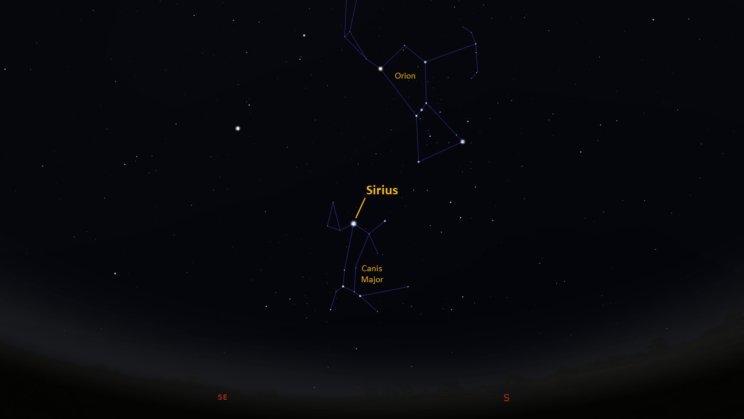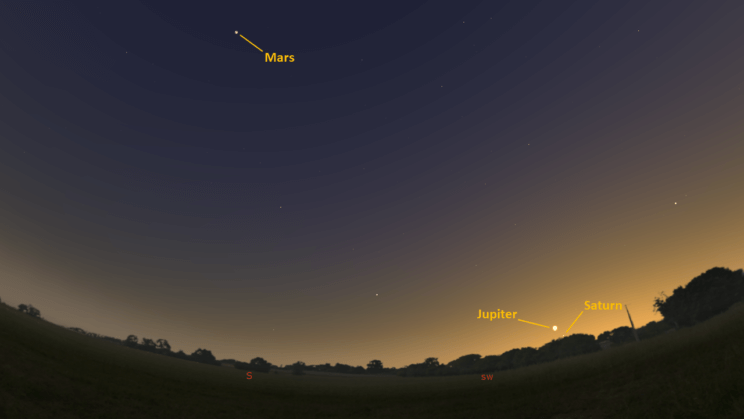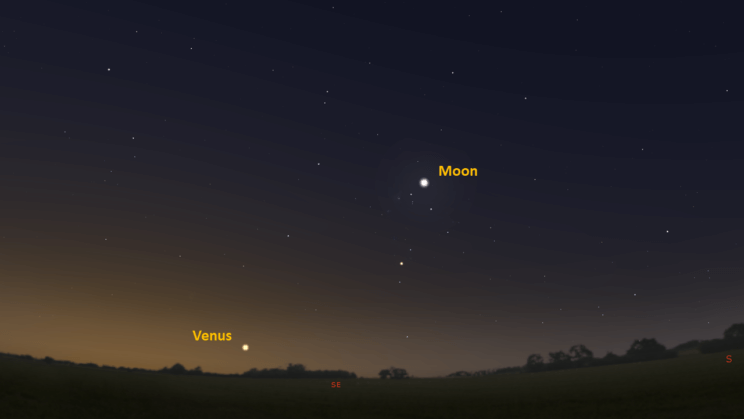This is the Saint Louis Science Center’s NIGHT SKY UPDATE for the week of Friday, January 8, 2020.
Information updated weekly or as needed.
Times given as local St. Louis time which is Central Standard Time (CST). For definitions of terminology used in the night sky update, click the highlighted text. If relying on times posted in Universal Time (UT), St. Louis is now -6 Hours from UT.
Public Telescope Viewings
Star parties at the Saint Louis Science Center have temporarily been canceled due to recommendations from the CDC regarding COVID-19. All public telescope events are canceled until further notice. As conditions change, we will reevaluate and update this article once public observing events resume.

Sirius Looking South at 10:00 pm, January 8, 2020
Credit: Stellarium, EG
Observing Highlight of the Week
The highlight this week is the star Sirius. Found in the constellation Canis Major, Sirius is the brightest star we can see at night. This is mostly owing to it closeness to us at 8.6 light years away.
The Egyptians named Sirius Sopdet who they saw as their god that was guarantor of fertility for land. For the Egyptians, this star was what indicated new year. Egyptian astronomers would look for when Sirius would rise just before the Sun. This is called a heliacal rise which for Sirius occurred around the annual flood season of the Nile River.
Sirius is an A-class star that is 25 times more luminous than the Sun. It is a great naked eye target in the winter that can help you get your bearings in the sky. It has a companion star called Sirius B. and the pair orbits one another at roughly 20 AU (20 times the Earth/Sun distance) on a period of 50.1 years.
The Sirius system is an interesting target for telescopes. Splitting the two stars with a telescope is possible, but it is very challenging due to the difference in their brightness. The main component Sirius A is -1.46 magnitude and Sirius B is 8.4. This means Sirius A appears 10,000 times brighter. To split the Sirius system, you will likely need to use a telescope with an aperture of 8 inches or bigger. You will also need excellent viewing conditions and high magnification. In an article from Sky and Telescope, it suggests you will need 300x magnification. One thing working in our favor is the two stars are just about as far apart from one another as we can see them. In orbits there are two points called apsides. These are the near and far points of an orbit. For stars the far point is called apoapsis which happened for the Sirius binary system in 2019.
Whether you want to see Sirius with a telescope of just your eyes, it is very easy to find. Sirius’s brightness alone should be enough to help you find it but to make sure you are looking at the right star, use Orion’s Belt. Orion’s belt has three stars that appear in a line. If you follow the direction the stars point to the left side of Orion, the path will take you right to Sirius. Sirius rises in the southeast early in the evening, but it will be best seen around 10:00 p.m.
The Sun and Moon

The Moon as seen from the International Space Station, on July 31, 2011.
Credit: NASA
Sunrise is at 7:19 a.m. on Friday, January 8 and sunset is at 4:57 p.m. providing us with less than 10 hours of daylight. Even after sunset, the light from the Sun will dimly illuminate our sky for about 1 hour and 30 minutes. This period is called twilight, which ends around 6:32 p.m. this week. For those with a sundial, local noon occurs around 12:08 p.m. this week.
| Day | Sunrise | Sunset |
|---|---|---|
| 2021-01-08 | 7:19 a.m. | 4:57 p.m. |
| 2021-01-09 | 7:19 a.m. | 4:58 p.m. |
| 2021-01-10 | 7:19 a.m. | 4:59 p.m. |
| 2021-01-11 | 7:19 a.m. | 5:00 p.m. |
| 2021-01-12 | 7:18 a.m. | 5:01 p.m. |
| 2021-01-13 | 7:18 a.m. | 5:02 p.m. |
| 2021-01-14 | 7:18 a.m. | 5:03 p.m. |
| 2021-01-15 | 7:17 a.m. | 5:04 p.m. |
| 2021-01-16 | 7:17 a.m. | 5:05 p.m. |
Moon
Moonrise for Friday, January 8 occurs at 2:22 a.m. and moonset will occur at 13:10 p.m. On Friday, January 8 the Moon will exhibit a waning crescent phase with 22% of the lunar disk illuminated. New moon occurs on January 12 at 11:00 p.m.
International Space Station (ISS) Observing

Visible passes of ISS from St. Louis for the week of January 8 occur during morning hours until January 16 when ISS returns to the evening sky. The best passes this week occur on the mornings of January 9 and 10. Use the table below for information about these and other visible passes this week.
Catch ISS from St. Louis starting Friday, January 8
| Date | Starts | Max. altitude | Ends | |||||||
|---|---|---|---|---|---|---|---|---|---|---|
| Time | Alt. | Az. | Time | Alt. | Az. | Time | Alt. | Az. | ||
| 09 Jan | -2.1 | 05:07:35 | 34 | ESE | 05:07:35 | 34 | ESE | 05:09:38 | 10 | ESE |
| 10 Jan | -2.2 | 05:55:06 | 21 | SW | 05:55:06 | 21 | SW | 05:57:41 | 10 | S |
| 11 Jan | -1.2 | 05:09:44 | 16 | SSE | 05:09:44 | 16 | SSE | 05:10:35 | 10 | SSE |
| 16 Jan | -1.2 | 19:23:45 | 10 | SW | 19:24:52 | 19 | SW | 19:24:52 | 19 | SW |
Magnitude (Mag): The Measure of brightness for a celestial object. The lower the value is, the brighter the object will be.
Altitude (Alt): The angle of a celestial object measured upwards from the observer’s horizon.
Azimuth (Az): The direction of a celestial object, measured clockwise from an observer’s location with north being 0°, east being 90°, south being 180° and west being 270°.
For information about ISS flyovers and other visible satellites, visit www.heavens-above.com
Detailed information regarding all unmanned exploration of our universe, missions past, present, and planned, can be found at Jet Propulsion Laboratories:
The Visible Planets

Looking South, at 5:30 pm, January 8, 2020
Credit: Stellarium, EG

Looking Southeast, 6:30 am, January 9, 2020
Credit: Stellarium, EG
This week, five naked eye planets are visible. Jupiter and Saturn are found in the southwest however this could be the last week for us to see them. As we lose Jupiter and Saturn, Mercury will join the evening sky later this week. Mars is found high in the south after sunset. Venus can be found in the eastern sky before sunrise.
Mercury
Mercury is starting its first evening apparition of 2021. The elusive planet will become visible later this week as it heads towards greatest eastern elongation on January 23. Near the end of the week head outside about 40 minutes after sunset and look to the southwest.
Venus
Venus rises at 6:18 a.m. and will be tough to see around 6:50 a.m. Venus remains a morning object until March 26, 2021 when it reaches superior conjunction. Since Venus has passed greatest western elongation, it is exhibiting a gibbous phase.
Mars
Currently Mars appears as a 0.0-magnitude object that will be visible high in the south about 30 minutes after sunset. Mars sets by 1:21 a.m. We are still near enough to Mars that surface features are visible through telescopes. Earth is moving away from Mars which means Mars is getting fainter each night. The observing season for this apparition ends around March 10, 2021 and superior conjunction occurs on October 7, 2021.
Jupiter
Look for Jupiter in the south about 30 minutes after sunset. Jupiter will set at 6:08 p.m. Those with a telescope can enjoy views of Jupiter’s cloud features and the Great Red Spot when it is pointed towards Earth.
Saturn
Look for the ringed planet in the south about 30 minutes after sunset. Saturn sets at 5:57 p.m. For those with a telescope keep track of the orientation of Saturn’s rings. Since Saturn is tilted on its rotational axis, we cross the plane of Saturn’s ring every 13 to 15 years. We are headed towards another ring plane crossing on March 23, 2025. Over the next five years you will notice Saturn’s rings will gradually incline towards an edge on appearance.
Uranus
Uranus is not a planet we normally include in this section. Even at its dimmest, the giant planet does hover within naked eye visibility. That said, it is so close to the visible limit of the human eye it just is not reality for most of us to see Uranus without binoculars or a telescope. Uranus is just past opposition and as such, it is still easy to spot. You can find Uranus in the constellation Aries the Ram. The current magnitude for Uranus is 5.7. A finder chart for Uranus can be found here.
James S. McDonnell Planetarium
Night Sky Update: January 08-January 16, 2020






